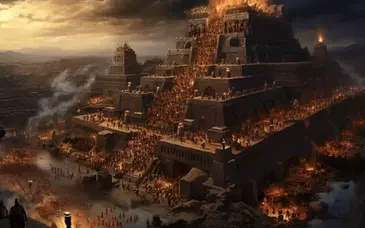Mesopotamia 9000 - 500 B.C
| B.C. | HISTORY | CULTURE |
|---|
Early Farming Communities 9000-5000
| 9000 | Beginning cultivation of wild wheat and barley and domestication of dogs and sheep; inaugurating of change from food gathering to food producing culture - Karim Shahir in Zagros foothills. | |
| 7000 | At Jarmo, oldest known permanent settlement: crude mud houses, wheat grown from seed, herds of goats, sheep, and pigs. | |
| 6000 | Migration of northern farmers settle in region from Babylon to Persian Gulf. | Hassuna culture introduces irrigation, fine pottery, permanent dwellings; dominates culture for 1000 years, develops tradefrom Persian Gulf to Mediterranean. |
Pre-Sumerians 5000-3500
| 5000 | Ubaidians develop first divisions of labor, mud brick villages, first religious shrines. Small temple at Eridu - earliest example of an offering table and niche for cult object. | |
| 4500 | ||
| 4000 | Semitic nomads from Syria and Arabian peninsula invade southern Mesopotamia, intermingle with Ubaidian population | Temple at Tepe Gawra built - setting style for later examples. |
Sumerians 3500-1900
| 3500 | Sumerians settle on banks of Euphrates | Temple at Eridu - zigguratprototype |
| 3000 | Democratic assemblies give way to kingships, evolve into hereditary monarchies. | |
| Kish - leading Sumerian city | Introduction of pictographs to keep administrative records. 3-D statues, e.g. Warka head. White Temple - ziggurat traditional design. Temple at Tell Uqair - mosaic decorations. cuneiform land sales formal contracts. Eridu and Kish - simple palaces. "Standard of Ur" - war-peace plaque, religious statues, gold and silver artifacts buried in tombs of Ur. Sumerians of Abu Salabikh - first poetry. | |
| 2750 | ||
| Gilgamesh, hero of Sumerian legends, reigns as king of Erech | ||
| 2500 | Lugalannemudu of Abab unites city states which vie for domination for 200 years. | |
| 2250 | Ur-Nammu founds Ur's 3rd. dynasty; dedicates ziggurat at Ur moon-god Nanna, sets up early law code. | Gudea, Prince of Lagsh, art and lit patron,magnificant statues produced in his honor. |
| 2000 | Elamites attack and destroy Ur. |
Babylonians and Assyrians 1900-500
| 1900 | Amorites from Syrian desert conquer Sumer. | |
| 1800 | Hammurabi asccends Babylonian throne. | |
| 1700 | Hammurabi brings most of Mesopotamia under his control. | Hammurabi introduces law code. |
| 1600 | Hittite invasion from Turkey ends Hammurabi's dynasty. | |
| 1500 | Assyria conquered by Hurrians from Anatolia. | Bas-relief of baked brick appears as dominant art form - Karaindash Temple. |
| 1400 | Kurigalzu assumes Babylonian throne | |
| 1200 | Nebuchadrezzar I expels Elamites. | |
| 1100 | King Tiglath-Pileser I leads Assyria to new era of power. | Iron, introduced originally by Hittites, is used extensively in Assyria for tools and weapons. |
| 1000 | Assyrian empire shattered by Aramaean and Zagros tribes. 150 Assyrian decline halted by Adadnirari II. | |
| 900 | Assurnasirpal II builds magnificent new capital, Calah, replacing old capital of Assur, present day Nimrud. | |
| 800 | Tiglath-Pileser II creates great empire extending from the Persian Gulf to the borders of Egypt. | Sargon II builds new capitol at Dur-Sharrukin |
| 700 | Assurbanipal extends empire from Nile to Caucasus Mountains. Chaldeans and Iranian Medes overrun Assyria - Neo-Babylonian empire. | Sennacherib's son, Esaraddon, rebuilds Babylon. |
| 600 | Nebuchadrezzar II rules Neo-Babylonian empire. Razes Jerusalem, takes Jews into captivity in Babylon. | Builds "Tower of Babel," temple to Marduk |
| 500 | Cyrus the Great, Persian warrior and statesman, conquers Babylon. |
Mesopotamia
The International History Project
Date: 2003

